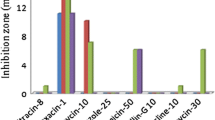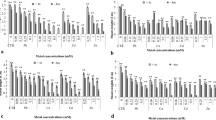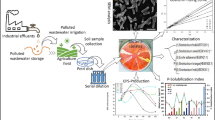Abstract
Remediation of heavy metal contaminated soil is a major problem or concern worldwide. Heavy metal accumulation in the soil is increasing day by day by industries, mines, agriculture, fuel combustion and municipal waste discharge. Such contaminated soils harbour a large number of resistant microbial populations. Screening and isolation of such microbes would be utilized for natural remediation of metal contaminated soils. Therefore, in the present study, highly copper-tolerant bacteria from rhizosphere soil of Cynodon dactylon grown in brass effluent contaminated soil were isolated and assessed for plant growth promoting factors. A total of 61 isolates were isolated from the rhizosphere of three contaminated sites. Six highly copper-tolerant isolates named as MYS1, MYS2, MYS3, MYS4, MYS5 and MYS6 were isolated through enrichment in copper containing nutrient broth. 16S rRNA analysis revealed that the isolates were from genera Stenotrophomonas and Brevundimonas and belong to classes Alpha Proteobacteriacea and Gamma Proteobacteriacea, respectively. Strain MYS1, MYS2 and MYS4 showed 95–99% similarity with Stenotrophomonas acidaminiphila, strain MYS3 and MYS5 showed 99 and 97% similarity with Stenotrophomonas maltophilia and Stenotrophomonas sp. Strain MYS6 showed 94% similarity with Brevundimonas diminuta. All the rhizobacteria showed plant growth promoting traits such as production of siderophores, indole acetic acid (IAA), phosphate solubilization and 1-aminocyclopropane-1-carboxylic acid (ACC) deaminase activity. From this study, we can conclude that all the isolates possess copper resistance and potential for phytoremediation of copper polluted soils.







Similar content being viewed by others
References
Aksorn E, Chitsomboon B (2013) The effects of plant growth promoting traits on heavy metal uptake of Vetiver grasss. Am-Eur J Agric Environ Sci 13:465–470
Altimira F, Yáñez C, Bravo G, González MA, Rojas L, Seeger M (2012) Characterization of copper-resistant bacteria and bacterial communities from copper-polluted agricultural soils of central Chile. BMC Microbiol 12:193
Andreazza R, Okeke BC, Lambais MR, Bortolon L, Bastos de Melo GW, Camargo FAO (2010) Bacterial stimulation of copper phytoaccumulation by bioaugmentation with rhizosphere bacteria. Chemosphere 81:1149–1154
Atlas RM, Bartha R (1998) Fundamentals and applications. In: microbial ecology, 4th edn. Benjamin/Cummings Publishing Company, Inc., California, USA, pp 523–530
Belimov AA, Hontzeas N, Safronova VI, Demchinskaya SV, Piluzza G, Bullitta S, Glick BR (2005) Cadmium-tolerant plant growth promoting rhizobacteria associated with the roots of Indian mustard (Brassica juncea L. Czern.) Soil Biol Biochem 37:241–250
Berg J, Brandt KK, Al-Soud WA, Holm PE, Hansen LH, Sørensen SJ, Nybroe O (2012) Selection for Cu-tolerant bacterial communities with altered composition, but unaltered richness, via long-term Cu exposure. Appl Environ Microbiol 78:7438–7446
Bhattacharya A (2010) Siderophore mediated metal uptake by Pseudomonas fluorescens and its comparison to iron (iii) chelation. Ceylon J Sci 39:147–155
Bolan NS, Naidu R, Mahimairaja S, Baskaran S (1994) Influence of low-molecular-weight organic acids on the solubilisation of phosphates. Biol Fert Soils 18:311–319
Bremner J (1960) Determination of nitrogen in soil by the Kjeldahl method. J Agric Sci 55:11–33
Burd GI, Dixon DG, Glick BR (1998) A plant growth-promoting bacterium that decreases nickel toxicity in seedlings. Appl Environ Microbiol 64:3663–3668
Cavalca L, Zanchi R, Corsini A, Colombo M, Romagnoli C, Canzi E, Andreoni V (2010) Arsenic-resistant bacteria associated with roots of the wild Cirsium arvense (L.) plant from an arsenic polluted soil, and screening of potential plant growth-promoting characteristics. Syst Appl Microbiol 33:154–164
Cervantes C, Gutierrez-Corona F (1994) Copper resistance mechanisms in bacteria and fungi. FEMS Microbiol Rev 14:121–137
Chehregani A, Malayeri BE (2007) Removal of heavy metals by native accumulator plants. Int J Agric Biol 9:462–465
Dell'Amico E, Cavalca L, Andreoni V (2008) Improvement of Brassica napus growth under cadmium stress by cadmium-resistant rhizobacteria. Soil Biol Biochem 40:74–84
Dhiman SS, Selvaraj C, Li J, Singh R, Zhao X, Kim D, Kim JY, Kang YC, Lee JK (2016) Phytoremediation of metal-contaminated soils by the hyperaccumulator canola (Brassica napus L.) and the use of its biomass for ethanol production. Fuel 183:107–114
Dworkin M, Foster JW (1958) Experiments with some microorganisms which utilize ethane and hydrogen. J Bacteriol 75:592–603
Farkas E, Csóka H, Micera G, Dessi A (1997) Copper (II), nickel (II), zinc (II), and molybdenum (VI) complexes of desferrioxamine B in aqueous solution. J Inorg Biochem 65:281–286
Fässler E, Evangelou MW, Robinson BH, Schulin R (2010) Effects of indole-3-acetic acid (IAA) on sunflower growth and heavy metal uptake in combination with ethylene diamine disuccinic acid (EDDS). Chemosphere 80:901–907
Feris K, Ramsey P, Frazar C, Moore JN, Gannon JE, Holbert WE (2003) Differences in hyporheic-zone microbial community structure along a heavy-metal contamination gradient. Appl Environ Microbiol 69:5563–5573
Gang A, Vyas A, Vyas H (2013) Toxic effect of heavy metals on germination and seedling growth of wheat. J Environ Res Dev 8:206–213
Ghosh A, Saha PD (2013) Optimization of copper bioremediation by Stenotrophomonas maltophilia PD2. J Environ Chem Eng 1:159–163
Ghosh P, Rathinasabapathi B, Ma LQ (2011) Arsenic-resistant bacteria solubilized arsenic in the growth media and increased growth of arsenic hyperaccumulator Pteris vittata L. Bioresour Technol 102:8756–8761
Glick BR, Penrose DM, Li J (1998) A model for the lowering of plant ethylene concentrations by plant growth promoting bacteria. J Theor Biol 190:63–68
Gordon SA, Weber RP (1951) Colorimetric estimation of indole acetic acid. Plant Physiol 26:192–195
Gordon AS, Howell LD, Harwood V (1994) Responses of diverse heterotrophic bacteria to elevated copper concentrations. Can J Microbiol 40:408–411
Gupta R, Rekha S, Aparna S, Kuhad RC (1994) A modified plate assay for screening phosphate solubilizing microorganisms. J Gen Appl Microbiol 40:255–260
Huang X, El-Alawi Y, Penrose DM, Glick BR, Greenberg BM (2004) A multi-process phytoremediation system for removal of polycyclic aromatic hydrocarbons from contaminated soils. Environ Pollut 130:465–476
Iyaka YA, Kakulu SE (2012) Topsoil contamination by heavy metals from a local brass industrial area of Nigeria. Resour Environ 2:86–89
Jang CS, Liu CW, Lin KH, Wang SW (2006) Spatial analysis of potential carcinogenic risk associated with ingesting arsenic in aquaculture tilapia (Oreochromis mossambicus) in black foot disease hyper endemic area. Environ Sci Technol 40:1707–1717
Khalid A, Arshad M, Zahir ZA (2004) Screening plant growth-promoting rhizobacteria for improving growth and yield of wheat. J Appl Microbiol 96:473–474
Kim BK, De Macario EC, Nolling J, Daniels L (1996) Isolation and characterization of copper resistant methanogens from a copper mining soil sample. Appl Environ Microbiol 62:2629–2635
Kozdroj J (1995) Microbial response to single or successive soil contamination with Cd2+ or Cu2+. Soil Biol Biochem 27:1459–1465
Li J, Xie ZM, Xu JM, Sun YF (2006) Risk assessment for safety of soils and vegetables around a lead/zinc mine. Environ Geochem Health 28:37–44
Ma Y, Rajkumar M, Freitas H (2009) Improvement of plant growth and nickel uptake by nickel resistant-plant growth promoting bacteria. J Hazard Mater 166:1154–1161
Ma Y, Oliveria RS, Nai F, Rajkumar M, Luo Y, Rocha I, Freitas H (2015) The hyperaccumulator Sedum plumbizincicola harbors metal-resistant endophytic bacteria that improve its phytoextraction capacity in multi-metal contaminated soil. J Environ Manag 156:62–69
Mathur N, Kumar A (2013) Physico-chemical characterization of industrial effluents contaminated soil of Sanganer. J Emerging Trends Eng and Appl Sci 4:226–228
Michels HT (2006) Anti-microbial characteristics of copper. ASTM Standardization News:28–31
Mujahid TY, Siddiqui K, Ahmed R, Kazmi SU, Ahmed N (2014) Isolation and partial characterization of phosphate solubilising bacteria isolated from soil and marine samples. Pak J Pharm Sci 27:1483–1490
Mumoz M, Pena L, Halloroms JO (1994) Use of an industrial by product as a liming source. J Agric Univ P R 78:195–202
Okalebo JR, Gathua KW, Woomer PL (1993) Laboratory methods of soil and plant analysis: a working manual tropical soil biology and fertility program. TSBF Institute, Nairobi, Kenya
Olsen SR, Cole CV, Watanabe FS, Dean LA (1954) Estimation of available phosphorus in soils by extraction with sodium bicarbonate. Washington, USDA
Opulencia RB, Bambase ME, Perdigon KMD, Demafelis RB, Llamado AA, Franco RAG, Mogul RT, Raymundo AK (2015) Copper-resistant, biofilm-forming bacteria for potential use in rehabilitation of copper-contaminated wastewater. Int J Phil Sci Technol 8:56–60
Oviasogie PO, Omoruyi E (2007) Levels of heavy metals and physicochemical properties of soil in a foam manufacturing industry. J Chem Soc Niger 32:102–106
Partha V, Murthya NN, Saxen PR (2011) Assessment of heavy metal contamination in soil around hazardous waste disposal sites in Hyderabad city (India): natural and anthropogenic implications. J Environ Res Manage 2:27–34
Pikovskaya RI (1948) Mobilization of phosphorus in soil connection with the vital activity of some microbial species. Microbiologiya 17:362–370
Płociniczaka T, Sinkkonenb A, Romantschukb M, Piotrowska-Sege Z (2013) Characterization of Enterobacter intermedius MH8b and its use for the enhancement of heavy metals uptake by Sinapis alba L. Appl Soil Ecol 63:1–7
Premono M, Moawad MA, Vleck PLG (1996) Effect of phosphate solubilizing Pseudmonas putida on the growth of maize and its survival in the rhizosphere. Indonesian J Crop Sci 11:13–23
Rajkumar M, Ae N, Prasad MNV, Freitas H (2010) Potential of siderophore-producing bacteria for improving heavy metal phytoextraction. Trends Biotechnol 28(3):142–149
Rathaur P, Ramteke PW, Raja W, John SA (2012) Isolation and characterization of nickel and cadmium tolerant plant growth promoting rhizobacteria from rhizosphere of Withania somnifera. J Biodiver Environ Sci 6:253–261
Sabry M, Shaheen CD, Tsadilas T (2009) Distribution coefficient of copper in different soils from Egypt and Greece. Commun Soil Sci Plant 40:214–226
Schwyn B, Neilands J (1987) Universal chemical assay for the detection and determination of siderophores. Anal Chemosphere 160:47–56
SEEPA (1995) Environmental quality standards for soils. State Environmental Protection Administration, China GB15618
Shakoori AR, Muneer B (2001) Copper-resistant bacteria from industrial effluents and their role in remediation of heavy metals in wastewater. Folia Microbiol 47:43–50
Sharma RS, Mohmmed A, Mishra V, Babu CR (2005) Diversity in promiscuous group of rhizobia from three Sesbania spp. colonizing ecologically distinct habitats of the semi-arid Delhi region. Res Microbiol 156:57–67
Sharma RS, Mishra V, Mohmmed A, Babu CR (2008) Phage specificity and lipopolysaccharides of stem and root-nodulating bacteria (Azorhizobium caulinodans, Sinorhizobium spp., and Rhizobium spp.) of Sesbania spp. Arch Microbiol 189:411–418
Singh Y, Ramteke PW, Shukla PK (2013) Isolation and characterization of heavy metal resistant Pseudomonas spp. and their plant growth promoting activities. Adv Appl Sci Res 4:269–272
Singh V, Ram C, Kumar A (2016) Physico-chemical characterization of electroplating industrial effluents of Chandigarh and Haryana region. J Civil Environ Eng 6:237. doi:10.4172/2165-784X.1000237
Song J, Zhao FJ, Luo YM, McGrath SP, Zhang H (2004) Copper uptake by Elsholtzia splendens and Silene vulgaris and assessment of copper phytoavailability in contaminated soils. Environ Pollut 128:307–315
Ssenku JE, Ntale M, Origa HO (2014) Physico-chemical characteristics of copper tailings and pyrite soils in western Uganda: implication for phytoremediation. Int J Environ Monit Anal 2:191–198
Walkley A, Black IA (1934) An examination of the degtjareff method for determining soil organic matter, and a proposed modification of the chromic acid titration method. Soil Sci 37:29–38
WHO (2010) Guideline for drinking water quality recommendations, (Vol. 1). World Health Organization, Geneva
Xiao J, Guo L, Wang S, Lu Y (2010) Comparative impact of cadmium on two phenanthrene-degrading bacteria isolated from cadmium and phenanthrene co-contaminated soil in China. J Hazard Mater 174:818–823
Xu J, Yang L, Wang Z, Dong G, Huang J, Wang Y (2006) Toxicity of copper on rice growth and accumulation of copper in rice grain in copper contaminated soil. Chemosphere 62:602–607
Zaidi S, Usmani S, Singh BR, Musarrat J (2006) Significance of Bacillus subtilis strain SJ-101 as a bioinoculant for concurrent plant growth promotion and nickel accumulation in Brassica juncea. Chemosphere 64:991–997
Zaki S, Farag S (2010) Isolation and molecular characterization of some copper biosorped strains. Int J Environ Sci Technol 7:553–560
Zhang YF, He LY, Chen ZJ, Wang QY, Qian M, Sheng XF (2011) Characterization of ACC deaminase-producing endophytic bacteria isolated from copper-tolerant plants and their potential in promoting the growth and copper accumulation of Brassica napus. Chemosphere 83:57–62
Zhuang X, Chen J, Shim H, Bai Z (2007) New advances in plant growth promoting rhizobacteria for bioremediation. Environ Int 3:406–413
Acknowledgements
The authors wish to acknowledge the Department of Science and Technology and Sophisticated Analytical Instrument Facility of IIT Madras for their support in metal analysis.
Author information
Authors and Affiliations
Corresponding author
Additional information
Responsible editor: Philippe Garrigues
Rights and permissions
About this article
Cite this article
Rathi, M., Nandabalan, Y.K. Copper-tolerant rhizosphere bacteria—characterization and assessment of plant growth promoting factors. Environ Sci Pollut Res 24, 9723–9733 (2017). https://doi.org/10.1007/s11356-017-8624-2
Received:
Accepted:
Published:
Issue Date:
DOI: https://doi.org/10.1007/s11356-017-8624-2




